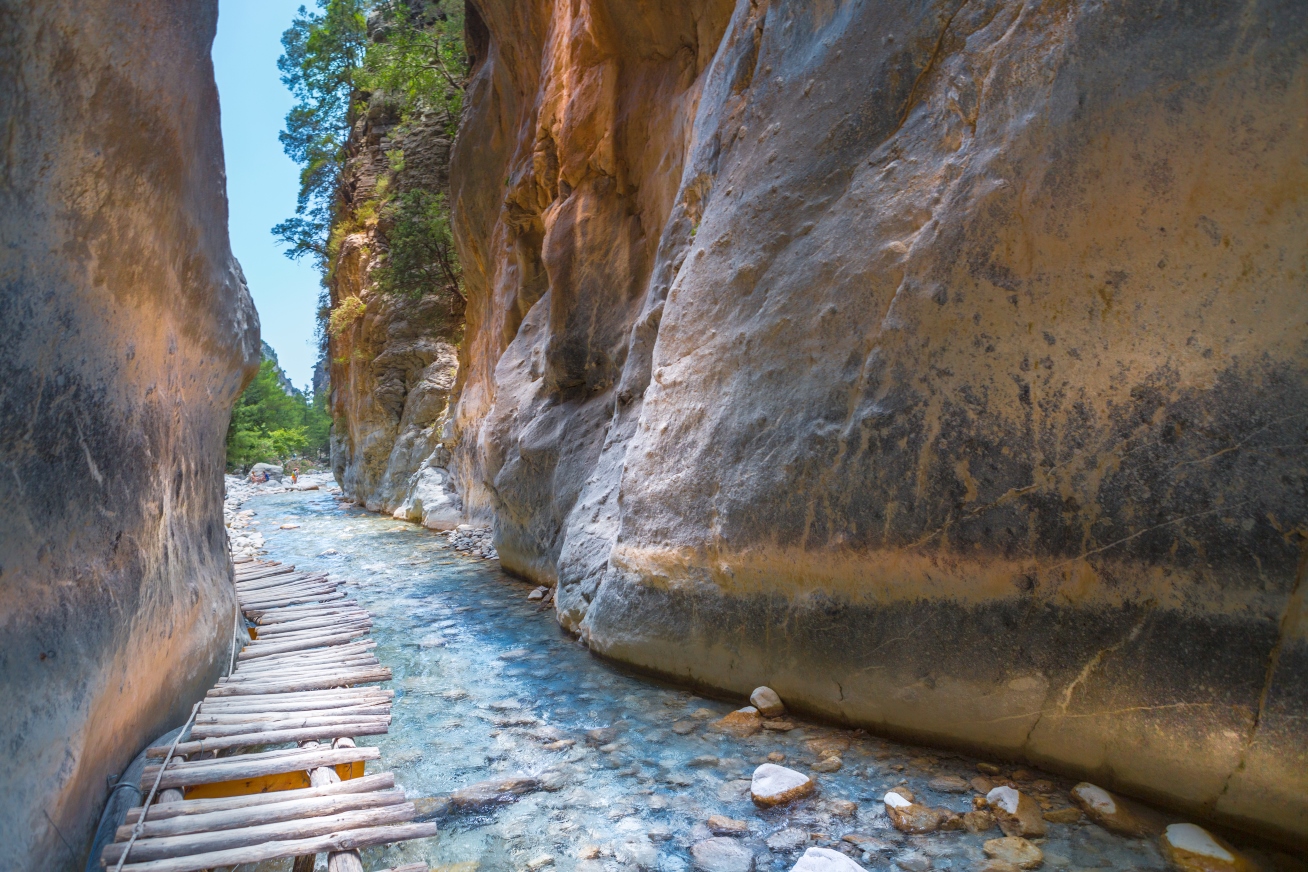
With more than 400 gorges making their mark on the Cretan landscape, due to land corrosion from the flow of river water, Crete is justifiably known as the King of Gorges in Greece. Cretan gorges are magnificent monuments of nature that will give you a sense of the beauty on this amazing Greek island. If you feel adventurous and love to uncover hidden natural treasures whilst on your travels, you should seek out at least one of the gorges in our list. The options for hiking on the island are endless, so we have narrowed down our top five Cretan gorges that combine outstanding beauty, unique scenery and easy to moderate hiking opportunities.
Always bear in mind that it is wise not to hike a gorge on your own, check the weather conditions (don’t enter if it is raining), and wear comfortable hiking shoes.
Samaria Gorge is the most famous Cretan gorge. With a length of 18 kilometres, it is known as the longest trekking gorge in Europe. Located on the sierra of the White Mountains in the Chania region, Samaria Gorge has a width that varies from 150 meters to a narrow three meters where the two rocky sides of the mountains (called “doors”) almost touch each other. Samaria Gorge is one of the most famous Greek National Parks where animals such as the Cretan goat and endemic birds find refuge, while rare plants and herbs grow on the steep land of the gorge.
Hiking in Samaria Gorges takes around six hours and is a great full day excursion starting from the top of the mountains and ending at blissfully car-free village of Agia Roumeli, by the sea. From Agia Roumeli, you have to take a boat to reach Chora Sfakion, where you can catch the public bus to Chania city.

Hiking Agia Irini Gorge with a local | Photo by Crete Urban Adventrues
Being part of the European Path E4 and with a length of 7.5 kilometres, the Gorge of Agia Irini is located in the west of the White Mountains, 43 kilometres from Chania. The name of the gorge is dedicated to the village and the church of Agia Irini, which is located near the north entrance. The estimated time required for crossing it is about three hours.
The whole gorge has a unique story due to its turbulent history during the Turkish Occupation when many Greek rebels found shelter here. Apart from the important monuments and sights you can visit during your hike in the gorge, you can admire the local flora and fauna, such as the endangered Cretan wild goat and various plants like cypress, pine, and dittany.
Located on the southern side of Psiloritis Mountain in the Heraklion region, Rouvas Gorge, also known as the gorge of Agios Nikolaos and Gafaris, is one of the most important gorges in Crete due to the rich ecosystem of its forest, the largest forest in Greece of this kind.
Start your hike from Lake Zaros and after 1.5 kilometres you’ll arrive at the monastery of Saint Nicholas before entering the gorge. Unfortunately, at the start of the hike the scenery is not so pleasant since in 1994 about one third of the gorge was burnt, but as you enter into the narrow gorge, you’ll admire the real beauty of the land. The length of the gorge is four kilometres and the route can be uphill or downhill.

Gorge of the Dead – just one of many stunning gorges in Crete | Photo by Crete Urban Adventures
Zakros Gorge, also known as Gorge of the Dead, is located in the Lasithi Region, around 39 kilometres southeast of Sitia. Being part of European Trail E4, Gorge of the Dead is a spectacular gorge with high, rocky walls and numerous caves that were used as tombs during the Minoan era.
You should start from Anos Zakros village and then pass through the gorge, and after two hours you should reach Kato Zakros, a seaside village where you can enjoy its beach and the taverns or continue your exploration in the nearby Minoan Palace of Zakros. It is highly recommended for lovers of wild Cretan beauty.

Discovering the imposing Imbros Gorge | Photo by Crete Urban Adventures
Located 57 kilometres southeast from the city of Chania, Imbros Gorge is named for the small community of Imbrian immigrants that arrived in the area in 1479, the year the island of Imbros (an island in the northeast Aegean Sea that now is part of Turkey) was occupied by the Ottoman empire. It is characterized by spectacular rock formations and a natural environment of exceptional beauty. However, the gorge also has a historical importance, at it played a role in the revolution of 1774 and is associated with the Anzacs during WW2.
To access the gorge, take the road from Chania that leads to Chora Sfakion. Park your car at the entrance of the gorge near the last houses of the Imbros village, and you will end your hike after eight kilometres in the village of Komitades. From there you can get a local “taxi” (it isn’t an actual taxi but locals with pickup trucks who do the transfer for an agreed amount), which will drive you back to your car.